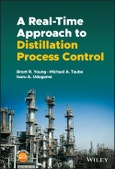A practical and hands-on discussion of modern distillation control
In A Real-time Approach to Distillation Process Control, a team of distinguished researchers and industrial practitioners delivers a practical text combining hands-on and active learning using process simulation with discussions of the fundamental knowledge and tools required to apply modern distillation control principles. The book offers a balanced, real-time approach integrated with practical insights. It includes many exercises designed to be simulator agnostic that can be performed on the process simulator locally available to the reader.
Readers will discover explorations of topics including distillation control hardware, distillation composition control, refinery versus chemical plant distillation control, distillation control tuning, advanced regulatory control, and more. They’ll also find: - A thorough introduction to distillation fundamentals, as well as basic and advanced modern controls from a practical point of view - Comprehensive explorations of known base controls combined with modern control practices - Practical discussions of hands-on modelling and simulation exercises, allowing the reader to design and tune controls on a distillation column - Fulsome treatments of control structure design integrated with controller tuning using a real-time approach
Perfect for senior undergraduate and graduate students studying general process control or distillation process control, A Real-time Approach to Distillation Process Control will also benefit plant managers, production supervisors, startup supervisors, operations engineers, production engineers, and chemical engineers working in industry.
Table of Contents
Dedication D.1
Preface P.i
References P.iii
Chapter 1: Introduction 1.1
1.1 The purpose of process control 1.1
1.1 Introduction to distillation 1.6
1.2 Distillation process control 1.9
1.3 A real-time approach to distillation process control education 1.10
Chapter 2: Fundamentals of Distillation Control 2.1
2.1 Mass & Energy balance: The only means to affect distillation tower's behavior 2.3
2.2 Control design procedure 2.8
2.3 Degrees of freedom 2.9
2.4 Pairing 2.14
2.5 Gain analysis 2.20
2.6 Common control configuration 2.22
2.7 Screening Control Strategies via Steady-State Simulation 2.25
Chapter 3: Control Hardware 3.1
3.1 Introduction 3.1
3.2 Control Hardware Overview 3.2
3.3 Sensors 3.3
3.4 Final Control Elements 3.15
3.5 Controllers/CPU 3.17
3.6 Modern Trends 3.22
Chapter 4: Inventory Control 4.1
4.1 Pressure control 4.1
4.2 Level control 4.12
Chapter 5: Distillation Composition Control 5.1
5.1 Temperature control 5.1
5.2 Actual composition control 5.10
5.3 More complex control configurations 5.13
5.4 Distillation control scheme design using steady state models 5.15
5.5 Performance Analysis using Steady-State Data for an Existing Distillation Tower 5.17
5.6 Distillation control scheme design using dynamic models 5.23
Chapter 6: Refinery Versus Chemical Plant Distillation Operations 6.1
6.1 New Generation of Refinery Controls 6.6
6.2 Improving thermodynamic efficiency through control 6.11
6.3 Blending and its implications on control 6.12
Chapter 7: Distillation Controller Tuning 7.1
7.1 Model identification: Step Testing 7.2
7.2 Typical process responses 7.5
7.3 Engineering Units versus Percent of Scale 7.6
7.4 Basics in PID Tuning 7.9
7.5 Tuning in distillation control 7.10
7.6 The role of tuning in a "value engineering" era 7.12
Chapter 8: Fine and Specialty Chemicals Distillation Control 8.1
8.1 Key Features 8.1
8.2 Measurement and Control Challenges 8.2
8.3 Nuances of Fine Chemicals Distillation 8.6
8.4 Side Draw Distillation 8.12
8.5 Composition Control in High Purity Side Draw Distillation 8.14
8.6 Advanced Distillation Column Configurations 8.17
8.7 Petlyuk and Divided Wall Columns 8.18
8.8 Optimal Design versus Optimal Operations 8.21
Chapter 9: Advanced Regulatory control 9.1
9.1 Introduction 9.1
9.2 Cascade Control 9.2
9.3 Ratio Control 9.8
9.4 Feedforward Control 9.12
9.4 Constraint/Override Control 9.15
9.5 Decoupling 9.17
Chapter 10: Model predictive control 10.1
10.1 Introduction to MPC 10.1
10.2 To MPC or not to MPC 10.2
10.3 MPC Fundamentals 10.3
10.4 Dynamic Matrix Control (DMC) 10.7
10.5 Setting up a MPC in Distillation 10.14
10.6 Digitalization and MPC10.20
Chapter 11: Plant wide control in distillation 11.1
11.1 Distillation column trains 11.2
11.2 Heat integration (energy recycle) 11.5
11 3 Materials Recycling 11.17
Tutorial and Self-Study Questions 11.20
References 11.22
Workshop 1 -- Hands on Learning by Doing W1.1
Course philosophy W1.1
Key Learning Objectives W1.1
Book Coverage W1.1
Prerequisites W1.2
Study Material W1.2
Organization W1.3
Simulation Tool W1.3
Overall Learning Objectives W1.4
Tasks W1.5
1 -- Get familiar with the simulator W1.5
2 -- Steady state tutorial W1.5
3 --Transitioning from steady state to dynamics tutorial W1.6
Tutorial and Self-Study Questions W1.6
Workshop 2 -- Fundamental Distillation Column Control W2.1
Introduction W2.1
Key Learning Objectives W2.1
Tasks W2.1
1 -- Steady State W2.1
2 -- Converting to Dynamics W2.4
3 -- Dynamics Exercises W2.9
Workshop 3 -- Distillation Column Model Predictive Control W3.1
Introduction W3.1
Key Learning Objectives W3.1
Description W3.2
Tasks W3.3
Workshop 4 -- Distillation Column Control in a Plantwide Setting W4.1
Introduction W4.1
Key Learning Objectives W4.1
Description W4.1
Tasks W4.3
References W4.7
Appendix A -- P&ID Symbols A.1
Index I.1








